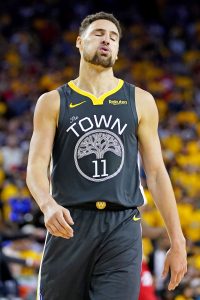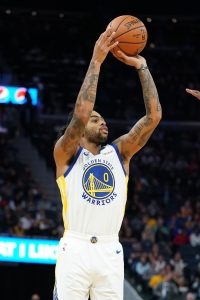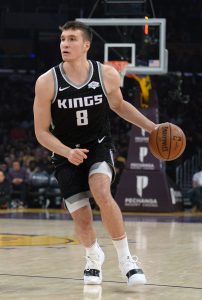Hoops Rumors is breaking down the 2019 offseason for all 30 NBA teams, revisiting the summer’s free agent signings, trades, draft picks, departures, and more. We’ll evaluate each team’s moves from the last several months and look ahead to what the 2019/20 season holds for all 30 franchises. Today, we’re focusing on the Golden State Warriors.
Signings:
- Standard contracts:

- Klay Thompson: Five years, maximum salary ($189.9MM). Re-signed using Bird rights.
- D’Angelo Russell: Four years, maximum salary ($117.33MM). Acquired via sign-and-trade.
- Kevon Looney: Three years, $14.46MM. Third-year player option. Re-signed using Bird rights.
- Willie Cauley-Stein: Two years, $4.46MM. Second-year player option. Signed using mid-level exception.
- Alec Burks: One year, minimum salary. Signed using minimum salary exception.
- Glenn Robinson III: One year, minimum salary. Signed using minimum salary exception.
- Two-way contracts:
- Non-guaranteed camp contracts:
Trades:
- Acquired the No. 41 pick in 2019 draft (used to select Eric Paschall) from the Hawks in exchange for the Warriors’ 2024 second-round pick and cash ($1.3MM).
- Acquired the draft rights to Alen Smailagic (No. 39 pick) from the Pelicans in exchange for the Warriors’ 2021 second-round pick, the Warriors’ 2023 second-round pick, and cash ($1MM).
- Acquired cash ($2MM) from the Jazz in exchange for the draft rights to Miye Oni (No. 58 pick).
- Acquired Julian Washburn (two-way) from the Grizzlies in exchange for Andre Iguodala, the Warriors’ 2024 first-round pick (top-four protected), and cash ($2MM).
- Note: Washburn was later waived.
- Acquired D’Angelo Russell (sign-and-trade), Treveon Graham, and Shabazz Napier from the Nets in exchange for Kevin Durant (sign-and-trade) and the Warriors’ 2020 first-round pick (top-20 protected).
- Note: If Warriors’ 2020 first-round pick lands in top 20, Nets will instead receive Warriors’ 2025 second-round pick.
- Acquired Omari Spellman from the Hawks in exchange for Damian Jones and the Warriors’ 2026 second-round pick.
- Acquired the draft rights to Lior Eliyahu from the Timberwolves in exchange for Treveon Graham, Shabazz Napier, and cash ($3.6MM).
Draft picks:
- 1-28: Jordan Poole — Signed to rookie contract.
- 2-39: Alen Smailagic — Signed to four-year, minimum-salary contract. Third and fourth years non-guaranteed. Signed using mid-level exception.
- 2-41: Eric Paschall — Signed to three-year, minimum-salary contract. Signed using mid-level exception.
Contract extensions:
- Draymond Green: Four years, $99.67MM. Fourth-year player option. Includes 15% trade kicker. Starts in 2020/21; runs through 2023/24 (with 2023 opt-out).
Departing players:
Other offseason news:
- Moved From Oracle Arena in Oakland to Chase Center in San Francisco.
- Klay Thompson out until at least All-Star break after undergoing ACL surgery.
- Signed president of basketball operations Bob Myers to a contract extension; signed president and COO Rick Welts to a contract extension.
- Hired Zaza Pachulia as consultant.
- Named Ryan Atkinson general manager of G League affiliate (Santa Cruz Warriors).
- Exercised 2020/21 rookie scale options on Jacob Evans, Omari Spellman.
Salary cap situation:
- Remained over the cap.
- Hard-capped; approximately $375K below hard cap.
- Carrying approximately $138.55MM in salary.
- Approximately $5.93MM over the tax line.
- $5.28MM of mid-level exception still available (used $3.97MM on Willie Cauley-Stein, Alen Smailagic, and Eric Paschall).
- Full bi-annual exception ($3.62MM) still available.
- Note: Due to hard cap, the Warriors would have to reduce salary elsewhere in order to use full MLE and/or BAE.
- Five traded player exceptions available; largest TPE ($17.19MM) expires 7/7/20.
Story of the summer:
No NBA team had a wilder, more up-and-down offseason than the Warriors, whose run of five consecutive appearances in the Finals was capped by a torn Achilles for Kevin Durant and a torn ACL for Klay Thompson, both of whom were about to become unrestricted free agents.
As the Warriors prepared to move across the bay from Oakland to San Francisco, they had to figure out whether they’d be able to re-sign two stars with multiple All-NBA nods under their belts, and how they’d replace those players if they didn’t return.
Fortunately, Thompson never seriously considered signing elsewhere and was locked up quickly once free agency opened. But Durant didn’t follow suit. After being linked to New York all year long, KD made his expected cross-country move, joining the Nets rather than the Knicks.
While losing Durant would seriously compromise the Warriors’ ability to maintain their dynasty, the team had shown over the years – and as recently as this spring – that it was a force to be reckoned with even without the two-time Finals MVP in its lineup. His departure would hardly launch a full-fledged rebuild in Golden State. It was simply a matter of deciding how to reload, with two paths potentially available to the Dubs.
Path one would have involved allowing Durant to walk outright. Without having to account for a maximum-salary contract for KD, the Warriors would have had the flexibility to bring back veteran contributors like Andre Iguodala and use their mid-level exception (taxpayer or non-taxpayer) to add another rotation player or two.
Instead, the Warriors chose path two. Recognizing that Durant’s departure may be their best – and only – opportunity to add a young star to their roster anytime soon, they worked out a sign-and-trade deal with Brooklyn that allowed them to acquire D’Angelo Russell in return.
While the idea of landing a young All-Star like Russell rather than losing Durant for “nothing” seems like a no-brainer on the surface, acquiring D-Lo came at a cost. By the time the dust had settled, the Warriors had to surrender Iguodala, Shaun Livingston, two future first-round picks (one heavily protected), and all their available trade cash for the league year ($5.6MM) in order to make the acquisition of Russell work.
That move also imposed a hard cap on the Warriors that will make it virtually impossible for the team to make any in-season roster changes or to even carry a full 15-man roster for most of the year. With Thompson already expected to spend most or all of the season on the shelf, Golden State essentially had to start the season down two roster spots, leaving little margin for error.
All those drawbacks don’t mean that acquiring Russell was the wrong move. But it put a lot of pressure on him, Stephen Curry, and Draymond Green to make up for the depth the Warriors sacrificed in the process.
Read more
Key offseason losses:
Although Curry remained the heart of the Warriors and the fan favorite throughout Durant’s stint with the team, it’s hard to argue that KD wasn’t the team’s best two-way player during that stretch. He transformed into a legit rim protector as a Warrior and posted the three best shooting percentages of his career in his three years in Oakland. While Curry and Thompson are two of the NBA’s best shooters of all time, Durant’s ability to simply elevate and shoot over a defender opened up new possibilities for the offense that the Warriors will have a hard time replacing.
Of course, Durant wasn’t the only Finals MVP the Warriors lost this summer. Iguodala will turn 36 in January and has become far more valuable in the postseason than he is during the regular season. But for a Warriors team experiencing so much turnover and missing a top perimeter defender like Thompson, Iguodala would have been a valuable asset to have for all 82 games in 2019/20. He’ll become eligible to rejoin the Warriors next July, and it wouldn’t be a surprise to see a one-year reunion at that point before Iguodala calls it a career.
Speaking of retirement, Livingston announced his this summer after being released by the Warriors. It’s not clear whether he would have continued his career if Golden State had been willing to keep him on the roster, but that was never really a viable option with or without the hard cap, since the size of his cap hit ($7.7MM) was beginning to outweigh his on-court contributions.
The Warriors’ hard cap may have played a part in their willingness to rescind qualifying offers for Quinn Cook and Jordan Bell, two young players who were restricted free agents. Bell took a step backward in 2018/19 after a promising rookie season, but Cook had developed into a reliable rotation player who played big minutes in the NBA Finals.
Big men Andrew Bogut and DeMarcus Cousins are also gone. Bogut returned to Australia after essentially being loaned to the Warriors for the stretch run, while Cousins left Golden State after a somewhat disappointing season — he had hoped to rebuild his value by playing a key role for a contender, but ultimately saw his year once again derailed by health issues. In retrospect, the uproar over his 2018 deal with the Warriors was overblown.
Role players Jonas Jerebko and Alfonzo McKinnie are gone too, with McKinnie sticking around all the way up until the weekend before the regular season before being cut in favor of Marquese Chriss. McKinnie was another casualty of the Warriors’ hard cap — without it, the team could have kept both players.
Key offseason additions:
 As noted above, the Warriors’ decision to work out a sign-and-trade with the Nets that allowed them to sign Russell to a maximum-salary deal essentially set the rest of their offseason moves in motion, subsequently limiting their cap flexibility and their ability to add depth. Was Russell worth it? The Warriors think so, rightly pointing out that the opportunity to land a 23-year-old All-Star doesn’t come along often for an over-the-cap team.
As noted above, the Warriors’ decision to work out a sign-and-trade with the Nets that allowed them to sign Russell to a maximum-salary deal essentially set the rest of their offseason moves in motion, subsequently limiting their cap flexibility and their ability to add depth. Was Russell worth it? The Warriors think so, rightly pointing out that the opportunity to land a 23-year-old All-Star doesn’t come along often for an over-the-cap team.
I’m a little less enthusiastic about Russell’s fit alongside Curry and Thompson and about his breakout year in Brooklyn, which only happened after an ankle injury sidelined Caris LeVert. He’s certainly a promising young player, and the Warriors will be able to flip him at some point if they want to, but now that he’s on a max deal, he’s no longer a bargain. If he’s traded at some point, Golden State shouldn’t necessarily count on getting another All-Star in the deal.
Willie Cauley-Stein, Alec Burks, and Glenn Robinson III joined the Warriors on modest contracts and figure to play regular roles. Burks and Robinson have flashed some upside as three-and-D wings, but have yet to show they can be above-average contributors for a contender. I’d be surprised if that changes. I did like the addition of Cauley-Stein though — he looked like he needed a fresh start after four seasons in Sacramento, and the Warriors got him at a bargain-basement price.
In addition to signing low-cost free agents, the Warriors also kept team salary below the hard cap by signing all three of the players they drafted in June: Jordan Poole, Alen Smailagic, and Eric Paschall. I didn’t expect any of the three to play major minutes for Golden State as rookies, but early-season injuries have forced Poole and Paschall into action.
Poole, predictably, has struggled, but Paschall, the No. 41 pick in this year’s draft, already looks like a steal. He’s averaging 16.7 PPG on 60.3% shooting through seven games, improbably earning “MVP” chants in San Francisco this week when he racked up 34 points in a win over Portland. He has been a bright spot in an otherwise disastrous couple weeks for the Dubs.
Omari Spellman and Chriss round out the Warriors’ offseason roster additions, giving the team a couple more options in the frontcourt. We’ll see how much Golden State can get out of those former first-rounders after their old teams decided to move on from them.
Outlook for 2019/20:
With Durant gone and Thompson injured, this was always going to be a transition year for the Warriors. I viewed them as a borderline playoff team entering the season, picking them to claim the No. 8 seed in the West in Hoops Rumors’ preseason predictions, buoyed primarily by an MVP-caliber season from Curry.
Now that Curry is expected to miss more than half the season with a broken hand, a spot in the postseason feels like a pipe dream. Even before Curry went down, Golden State looked like a potential lottery team, with opponents scoring at will on the Dubs’ ineffective defense.
While a core of Curry, Thompson, Green, and Russell is still a strong long-term foundation, this year’s team just doesn’t have the supporting pieces necessary to contend with two of those stars out until at least February. For the first time in several years, Warriors fans will likely end up anticipating the draft lottery in May more than the Finals in June.
Salary information from Basketball Insiders was used in the creation of this post. Photos courtesy of USA Today Sports Images.

 As noted above, the Warriors’ decision to work out a sign-and-trade with the Nets that allowed them to sign Russell to a maximum-salary deal essentially set the rest of their offseason moves in motion, subsequently limiting their cap flexibility and their ability to add depth. Was Russell worth it? The Warriors think so, rightly pointing out that the opportunity to land a 23-year-old All-Star doesn’t come along often for an over-the-cap team.
As noted above, the Warriors’ decision to work out a sign-and-trade with the Nets that allowed them to sign Russell to a maximum-salary deal essentially set the rest of their offseason moves in motion, subsequently limiting their cap flexibility and their ability to add depth. Was Russell worth it? The Warriors think so, rightly pointing out that the opportunity to land a 23-year-old All-Star doesn’t come along often for an over-the-cap team.